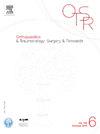使用 Aequalis 骨折植入物对肱骨近端骨折进行肱骨半关节成形术后大结节愈合的放射学评估:对 45 例肩关节进行的回顾性队列研究。
IF 2.3
3区 医学
Q2 ORTHOPEDICS
引用次数: 0
摘要
导言:开发和使用特定解剖假体治疗肩关节骨折的目的是使大结节达到最佳固位率,这意味着袖带恢复以改善功能效果。由于大结节的骨愈合不足,因此建议使用栅栏式肱骨假体,并在假体的骨骺部分进行骨移植。这种特殊植入物的特点在文献中鲜有报道,因此我们进行了这项回顾性研究,目的是:1)评估植入骨折专用解剖植入物后大结节的愈合率,该植入物包括在假体干骺端开孔,以添加皮质松质骨移植物;2)评估肱骨近端骨折患者靠近假体内骨移植物的大结节的骨愈合情况:假设:特定的 "植入物-骨折 "可使肱骨大结节的骨愈合率达到很高的水平。其中 6 例患者被排除在外(2 例为翻修手术,2 例为 3 周后手术,1 例死亡,1 例无随访)。共有 45 名患者接受了放射学分析,其中 23/45 名患者在最长的随访期内接受了临床分析,另外 22/45 名患者仅接受了放射学分析。平均年龄为66岁(47岁-88岁),25/45(56%)为女性,根据Neer分类法,骨折部位为3-4处。大结节固定的技术有孤立卡环、联合水平卡环和垂直缝合。在最长的随访期间(平均50个月,3至193个月),通过前后位和侧位X光片观察大结节的位置和愈合情况。研究人员注意到了围手术期的固定技术、临床和功能结果,并将其与大结节的放射学位置和移植物的演变联系起来。研究还调查了与愈合和解剖位置相关的因素:大结节愈合率为32/45(73%)。与大结节愈合明显相关的因素是年龄较高(p = 0.04)和在大结节水平缝合的基础上增加垂直骨缝(p = 0.01)。大结节解剖位置的比例为15/45(33%)。当采用垂直缝合固定大结节时,在最长的随访中,68%的病例(17/24)观察到大结节位置良好:讨论:我们的研究结果与文献报道一致,但本研究强调了文献中影响结节愈合的两类因素:结节固定技术和患者年龄。本文章由计算机程序翻译,如有差异,请以英文原文为准。
Radiologic evaluation of the healing of the greater tubercle after humeral hemiarthroplasty with Aequalis-fracture-implants for proximal humeral fracture: a retrospective cohort study in 45 shoulders
Introduction
Development and use of specific anatomic prosthesis for shoulder’s fracture aimed to reach the best rate of consolidation of the greater tubercle, which means a cuff restitution to improve functional results. The lack of bone healing of the tubercles suggested the use of a fenestrated humeral implant with interposition of a bone graft in the metaphyseal part of the prosthesis. This characteristic of specific implant, have few reports in the literature, leading us to the current retrospective study aiming: 1) to evaluate the healing rate of the greater tubercle after implantation of fracture dedicated anatomic implant, which includes a fenestration in the prosthetic metaphysis for the addition of a cortico cancellous graft, 2) to asses on patients with proximal humerus fractures, the bone healing of the greater tubercle close to the intraprosthetic bone graft.
Hypothesis
The specific “implant-fracture” can achieve a high rate of bone healing of the humeral greater tubercle.
Patients and methods
Between January 2001 and December 2020, fifty-one patients were operated on by implantation of fracture dedicated implant for proximal humerus fracture. Six were excluded (2 operated for revision, 2 operated after 3 weeks, 1 died, 1 without follow-up). In total 45 patients were included in radiological analysis, clinical analysis had been performed on 23/45 patients at the longest follow up, the other 22/45 were only analyzed on radiographies. Mean-aged 66 years (range, 47 years -88 years), 25/45 (56%) of women, with 3–4-parts fractures according to Neer’s classification. The techniques of tubercle fixation were isolated cerclages of combined horizontal cerclages and vertical sutures. Position and healing of the greater tubercle was controlled through antero-posterior and lateral X-Rays views at the longest follow-up (mean 50 months, range 3–193 months). Peroperative techniques of fixation, clinical and functional outcomes were noted and correlated to the radiologic position of the greater tubercle and the graft evolution. Factors associated with healing and anatomic position had been investigated.
Results
The rate of greater tubercle healing was 32/45 (73%). Factors significantly associated with greater tuberosity consolidation were higher age (p = 0.04) and the addition of a vertical osteosuture to the horizontal suture of the greater tubercle (p = 0.01). The rate of anatomic position of the greater tubercle was 15/45 (33%) of cases. When the fixation of the tuberosity was made with vertical suture, good position of the tuberosity was observed in 68% (17/24) at the longest follow-up.
Discussion
Our results were in accordance with the literature, but the current study underlined there were two types of factors influencing tubercle healing in the literature: the technique of fixation of the tubercle and the patient’s age.
Level of evidence
level IV cohort study without control group.
求助全文
通过发布文献求助,成功后即可免费获取论文全文。
去求助
来源期刊
CiteScore
5.10
自引率
26.10%
发文量
329
审稿时长
12.5 weeks
期刊介绍:
Orthopaedics & Traumatology: Surgery & Research (OTSR) publishes original scientific work in English related to all domains of orthopaedics. Original articles, Reviews, Technical notes and Concise follow-up of a former OTSR study are published in English in electronic form only and indexed in the main international databases.

 求助内容:
求助内容: 应助结果提醒方式:
应助结果提醒方式:


